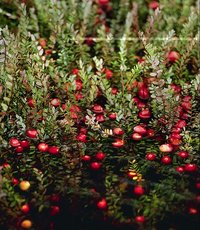| Cranberry | ||||||||||||||
|---|---|---|---|---|---|---|---|---|---|---|---|---|---|---|
| Scientific classification | ||||||||||||||
| ||||||||||||||
| Species | ||||||||||||||
| Vaccinium macrocarpon |
The cranberries are a group of evergreen dwarf shrubs in the genus Vaccinium subgenus Oxycoccus, or in some treatments, in the distinct genus Oxycoccus. They are found in acidic bogs throughout the cooler parts of the Northern Hemisphere. The name cranberry derives from their being a favourite food of cranes. Some sources claim the name comes from "'craneberry' because before the flower expands, its stem, calyx, and petals resembled the neck, head, and bill of a crane" (e.g., American Phytopathological Society; Nantucket Conservation Foundation). They are low, creeping shrubs to 10 cm tall (often less), with slender, wiry stems, not thickly woody, and small evergreen leaves. The flowers are dark pink, with very distinct reflexed petals, leaving the style and stamens fully exposed and pointing forward. The fruit is a small pink berry.
There are three species of cranberry:
- Vaccinium oxycoccus or Oxycoccus palustris (Common Cranberry or Northern Cranberry) is widespread throughout the cool temperate Northern Hemisphere, including northern Europe, northern Asia and northern North America. It has small 5-10 mm leaves. The flowers are dark pink, with a purple central spike, produced on finely hairy stems. The fruit is a small pale pink berry, with a refreshing sharp acidic flavour.
- Vaccinium microcarpum or Oxycoccus microcarpus (Small Cranberry) occurs in northern Europe and northern Asia, and differs from V. oxycoccus in the leaves being more triangular, and the flower stems hairless.
- Vaccinium macrocarpon or Oxycoccus macrocarpus (American Cranberry) native to the northeastern part of the North American continent (eastern Canada, and eastern United States south to North Carolina). It differs from V. oxycoccus in the leaves being larger, 10-20 mm long.

The cranberries are related to the bilberries, blueberries, and huckleberries, all in Vaccinium subgenus Vaccinium. These differ in having stouter, woodier stems forming taller shrubs, and in the bell-shaped flowers, the petals not being reflexed.
Uses and cultivation
Cranberries have been eaten by Arctic peoples for millennia and remain a very popular fruit for wild harvesting in the Nordic countries and Russia. In Scotland the berries were formerly wild harvested but with the loss of suitable habitat, the plants have become so scarce that this is no longer done. In North America, Native Americans were the first to recognise and use the cranberry as a source of food. Some tribes called the red berries Sassamanash. They are reported to have introduced the cranberry to starving English settlers in Massachusetts around 1620, who incorporated the berry into the traditional Thanksgiving feast. American Revolutionary War veteran Henry Hall is alleged to be the first to cultivate the cranberry commercially, in the Cape Cod town of Dennis around 1816.
Commercial cranberry fields today are diked so they may be flooded. When the berries are ripe, they float, making harvesting a matter of flooding the field, shaking the bushes a bit, and skimming off the berries into waiting trucks.
Usually cranberries are served as a compote or jelly, but sometimes they are incorporated in other ways. Cranberry juice, usually sweetened and often mixed with other fruit juices, is a major use of cranberries. The berry is often used in baking (muffins and cakes) and for medicinal purposes.
There is some use of cranberry juice by people with spinal paralysis; regular consumption of the juice is supposed to reduce the rate of urinary tract infections. While much of the evidence is equivocal, a number of double-blind clinical trials have been carried out that suggest there actually is an effect: a component of the juice appears to competitively inhibit bacterial attachment to the ureter.
An Autumn 2004 caution from the Committee on Safety of Medicines (the UK agency dealing with drug safety) advises patients on warfarin to stay off cranberry juice after adverse effects were reported.
In North-Eastern Canada a cranberry is also referred to as a mossberry.
External links
- October 2004 "Current Problems in Pharmacovigilance" (pdf file)) - has warfarin and cranberry juice caution, p. 10
- 2001 review (http://carecure.rutgers.edu/spinewire/Articles/Cranberry_UTI.htm) of evidence for therapeutic effects of cranberry juice
- 1989 study ) of cranberry juice's possible role in inhibiting bacterial adherence to bladder cells
- Red, round, and profitable The Economist, Dec 16th 2004
- The Cranberry Institute (http://www.cranberryinstitute.org) for information on cranberry's health benefits.
- Nutrition information for cranberries (http://www.kallipolis.com/diet/food.php?id=16019)

